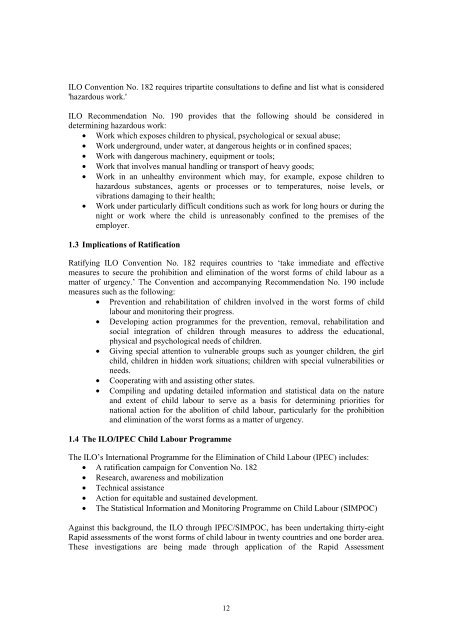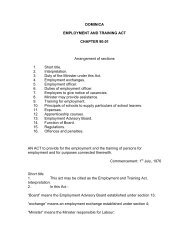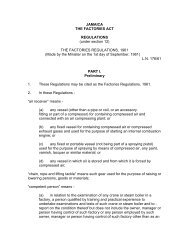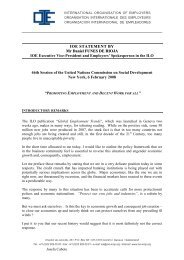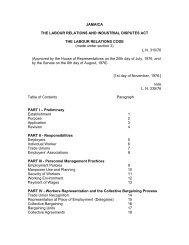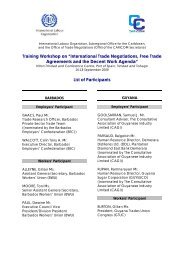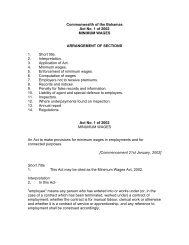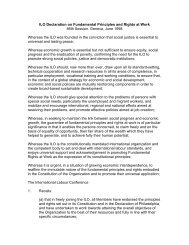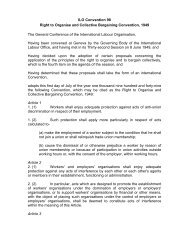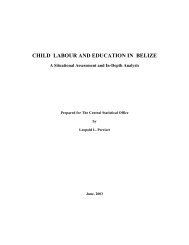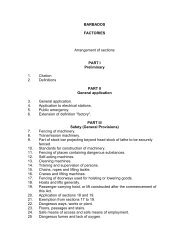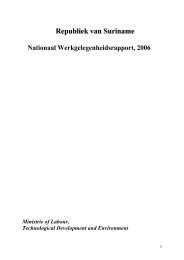ILO REPORT ON CHILD LABOUR IN BARBADOS - International ...
ILO REPORT ON CHILD LABOUR IN BARBADOS - International ...
ILO REPORT ON CHILD LABOUR IN BARBADOS - International ...
Create successful ePaper yourself
Turn your PDF publications into a flip-book with our unique Google optimized e-Paper software.
<strong>ILO</strong> Convention No. 182 requires tripartite consultations to define and list what is considered<br />
'hazardous work.'<br />
<strong>ILO</strong> Recommendation No. 190 provides that the following should be considered in<br />
determining hazardous work:<br />
• Work which exposes children to physical, psychological or sexual abuse;<br />
• Work underground, under water, at dangerous heights or in confined spaces;<br />
• Work with dangerous machinery, equipment or tools;<br />
• Work that involves manual handling or transport of heavy goods;<br />
• Work in an unhealthy environment which may, for example, expose children to<br />
hazardous substances, agents or processes or to temperatures, noise levels, or<br />
vibrations damaging to their health;<br />
• Work under particularly difficult conditions such as work for long hours or during the<br />
night or work where the child is unreasonably confined to the premises of the<br />
employer.<br />
1.3 Implications of Ratification<br />
Ratifying <strong>ILO</strong> Convention No. 182 requires countries to ‘take immediate and effective<br />
measures to secure the prohibition and elimination of the worst forms of child labour as a<br />
matter of urgency.’ The Convention and accompanying Recommendation No. 190 include<br />
measures such as the following:<br />
• Prevention and rehabilitation of children involved in the worst forms of child<br />
labour and monitoring their progress.<br />
• Developing action programmes for the prevention, removal, rehabilitation and<br />
social integration of children through measures to address the educational,<br />
physical and psychological needs of children.<br />
• Giving special attention to vulnerable groups such as younger children, the girl<br />
child, children in hidden work situations; children with special vulnerabilities or<br />
needs.<br />
• Cooperating with and assisting other states.<br />
• Compiling and updating detailed information and statistical data on the nature<br />
and extent of child labour to serve as a basis for determining priorities for<br />
national action for the abolition of child labour, particularly for the prohibition<br />
and elimination of the worst forms as a matter of urgency.<br />
1.4 The <strong>ILO</strong>/IPEC Child Labour Programme<br />
The <strong>ILO</strong>’s <strong>International</strong> Programme for the Elimination of Child Labour (IPEC) includes:<br />
• A ratification campaign for Convention No. 182<br />
• Research, awareness and mobilization<br />
• Technical assistance<br />
• Action for equitable and sustained development.<br />
• The Statistical Information and Monitoring Programme on Child Labour (SIMPOC)<br />
Against this background, the <strong>ILO</strong> through IPEC/SIMPOC, has been undertaking thirty-eight<br />
Rapid assessments of the worst forms of child labour in twenty countries and one border area.<br />
These investigations are being made through application of the Rapid Assessment<br />
12


